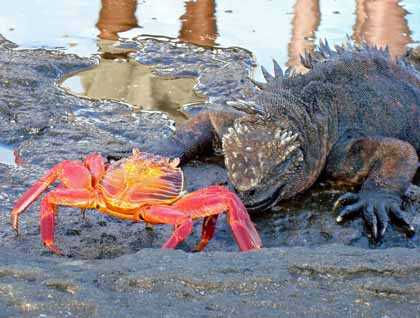Santiago is the third biggest island of the seventeen forming this marvelous archipelago. This morning we are at Espumilla beach, a place where the four kinds of mangroves we have in Galapagos are found. Black, red, white, and button mangroves are shelter for hawks, ghost crabs, shells, pelicans, and tons of green Pacific marine turtles that comes here to this golden sandy beach to lay their eggs. In fact we found 12 tracks made the night before by six females turtles that late at night came above the sand dunes to work for the survival of the species, and early in the morning went back to the ocean. Mockingbirds, finches, and Galapagos flycatchers are also inhabitants of the mangroves forests. They are busy building their nests on thorny trees and bushes and the whole area looks green and grassy, with blooming flowers everywhere. It’s really beautiful, the scenery completely different now during the rainy season in Galapagos.
Nevertheless, this morning is sunny and far in the distance we saw a rainbow - a clear sign that the night before it was raining. We landed on the beach for a walk and behind it there was a nice lagoon that looks great with the reflection of the “Palo Santo” trees in the water. Some cattle egrets, whimbrels, and pintails ducks swim in it in search of some microscopic mollusks and crustaceans found in the ooze. We walked inland and the sound of the land birds was the best music for our ears. Our hike was quiet, and we enjoyed the music of nature and the pureness of the air. Back at the beach we found a Galapagos hawk sitting on the top of a black mangrove - the frosting on the cake for such a nice and relaxing adventure.
After breakfast we moved from Espumilla Beach to Buccaneer’s Cove. Once there, some of us went to the caves to admire the wildlife in this beautiful place. Others went snorkeling along the coast where we found a variety of fish, playful sea lions that stayed with us for a few minutes, and even sharks!
In the afternoon, after a few minutes of navigation, we anchored on Puerto Egas – a place where about 60 years ago people tried to colonize. Not far from the beach we disembarked near a place where there is a salt mine. This was one of man’s enterprises while attempting to colonize the area, but in the end it was a failure.
While some guests opted to stay on the beach to relax, swim, or snorkel, others chose to walk along the coast to the grottos where we have a very important colony of fur sea lions. This is our only chance to see them so closely because usually they spend their time on cliffs or other inaccessible places. On our way back, we spotted many migratory birds and marine iguanas.
Once we returned to the beach, the sun was beginning to set on another beautiful day and everyone had smiles on their faces from all the amazing adventures they had just experienced.







